Absolutely Yes! Snowy Owls can see at night. They have excellent night vision. This is the reason why they are well adapted to hunt in low light conditions, including twilight and at night. According to the study, snowy owls have a high density of photoreceptor cells in their retinas, particularly cone cells. That’s why their bulging eyes can perceive even the slightest changes in light and shadow. Also, they have specialized cells used for low-light vision.
Snowy owls are popular due to their large and forward-facing eyes. Their unmovable big eyes are a characteristic feature of most owl species. Moreover, their eyes are uniquely structured to optimize their visual capabilities. They have a larger cornea and pupil compared to other diurnal birds, allowing more light to enter the eye. Snowy owls also have a tapetum lucidum, a reflective layer behind the retina that enhances light-gathering capabilities.
Do you have an idea how far snowy owls can see at night? How do their enormous eyes make them incredible night hunters? We are going to discuss all the special eyes of snowy owls in this article. Let’s follow up on the blueprints of this article to find interesting facts about the Arctic owls’ eyes. We’ll answer this burning question broadly: Can these mind-blowing owls see at night?
Can Owls See Day or Night?
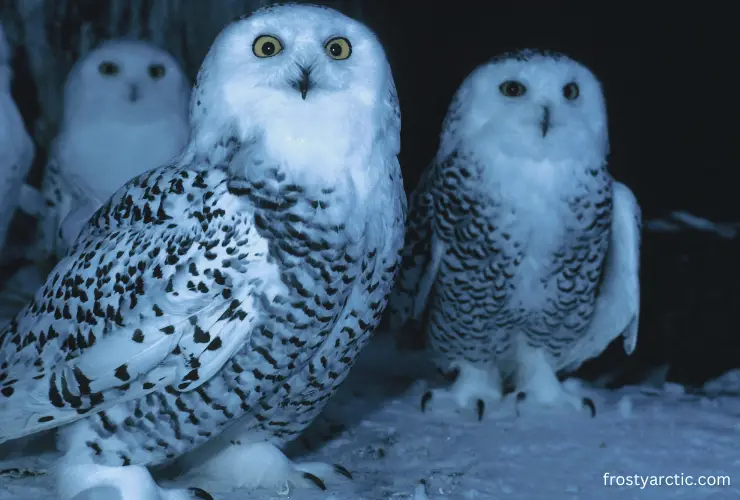
Snowy owls can see objects during the day and at night. They can see their prey from the high-up skies. It is best for snowy owls to swoop down silently and slowly to capture their prey. The credit goes to their incredible vision. But there are also other reasons that support their ability to see in the dark.
Snowy Owls are not just nocturnal but also crepuscular. Nocturnal means they can hunt at night, and most owls are nocturnal. On the other hand, crepuscular means they can hunt during the twilight periods (dusk and dawn).
Lemmings, voles, rodents, and mice, which are the snowy owls’ preferred prey, are active at night. That’s why snowy owls have the physical adaptations of sharp hearing and incredible vision to hunt easily at night. Many characteristics make their eyes see in dim light.
How Do Owls See in The Dark?
The snowy owls’ eyes are just like human eyes and work with the same function. The light penetrates their pupil with the help of the cornea and traverses the lens. The collaboration between the lens and cornea enables the convergence of light onto the retina, positioned at the back of the ocular structure.
The eyes of snowy owls have specialized cells known as photoreceptors. These cells can convert incoming light into electrical impulses, which then traverse the optic nerve to reach the brain.
Then, the brain of the snowy owl processes this data, comprehends its significance and translates it into a coherent visual representation.
Furthermore, photoreceptors present in the retina have two types of cells:
- Cone-shaped cells
- Rod-shaped cells
And, what’s the functionality of both types of photoreceptors? Retinal cones operate optimally under the condition of the availability of high levels of light (photopic vision). It plays a vital role in spatial acuteness (sharp spatial details) and color vision.
On the other hand, retinal rods take charge of vision under dim lighting conditions (scotopic vision). It can exclusively process information in shades of black and white.
In the eyes of snowy owls, the retina has a significant number of densely clustered retinal rods. Remarkably, the number of rods is greater than that of cones by approximately 30-fold. It means snowy owls cannot see colors at night, but their night-time vision is excellent. There are some myths about snowy owls’ vision: they cannot see at night. But this is not true!
Snowy Owls have the remarkable capability to adjust their pupils in bright light. They can regulate the amount of incoming light with their big eyes. In the daytime, snowy owls can close their big eyes to partially block unwanted light. They often look like half-asleep owls, but the story is different. They are actually alert and awake. ~ Source
Important Fun Fact: The big eyes of snowy owls make up 5% of their overall body weight. If we compare the weight and size of snowy owls’ eyes with human eyes, the human eyes are much smaller than their body weight. Human eyes make up only 0.02% of their overall body mass. Just think about the difference!
Why Snowy Owls Cannot Move Their Eyes?
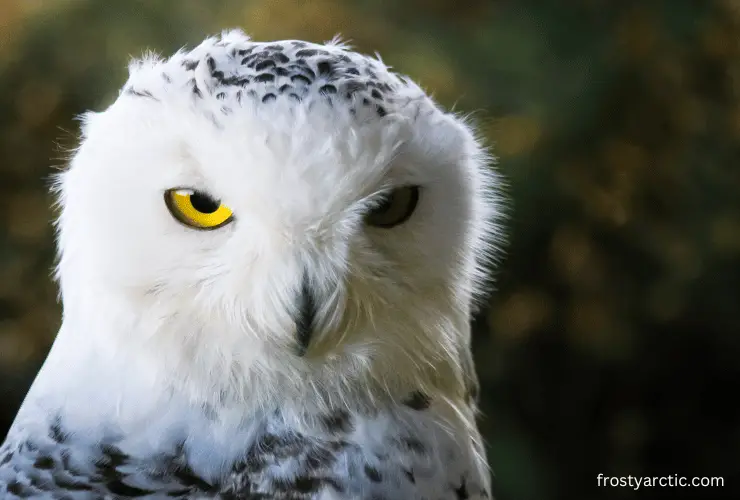
We all know that snowy owls cannot move their big eyes. That’s why they move their heads to look around. They can rotate their heads up to 270 degrees by rotating their necks. They can move their necks around without injuring themselves.
The reason is that humans’ and animals’ necks are connected to two-socket pivots, while the necks of all owls are connected to one socket pivot.
Their neck bones also have holes in them to protect the arteries without hurting them. In fact, holes act as cushions. Interestingly, the eyes of snowy owls are not spherical. They are actually elongated tubes that are fixed in their static bony skull structure. This fixed bony structure is known as a “sclerotic ring” in bioscience.
Binocular Vision of Snowy Owls
Snowy Owls have binocular vision. Do you have any idea what it means? Let’s make it simple! The eyes of snowy owls are located in front of their heads rather than on the sides of their heads. Biologically, this is known as binocular vision.
The advantage of this type of vision is that snowy owls can see things in 3 dimensions with the help of both eyes. They can see the following at the same time:
- Increased depth perception
- Height
- Width
It’s fun fact time: A snowy owl’s “field of view” is 110°, of which 70° only consists of binocular vision. We are aware that they do not have eyes on either side of their heads. Otherwise, they would have a larger field of view. It could be 300°. However, binocular vision would be much lower with side eyes, as low as 10°.
What Is the Disadvantage of the Large Eyes of Snowy Owls?
There are many benefits associated with the big, round eyes of snowy owls. But there is a disadvantage too. They cannot focus clearly or see near objects. Simply put, snowy owls are long-sighted. Now, how do they sense the nearly placed objects? How do they compensate for it?
Snowy Owls have crines placed right around their beaks. These are bristles-like short feathers. Crines help them sense nearly placed objects. For example, they can find out if the prey they caught is dead or alive. Credit directly goes to “Crines” which are touch-sensitive and help to perceive movements.
Do You Know What Crines is?
Crines are known as the first feathers of snowy owls. These are developed in the chicks right after a few days of their birth. In this way, they can find out what the prey is and where it was brought to them by their parents. Crines also help remove unwanted blood from the owls’ beaks for their well-being and good health. It prevents them from getting sick!
How Far Can Snowy Owls See at Night?
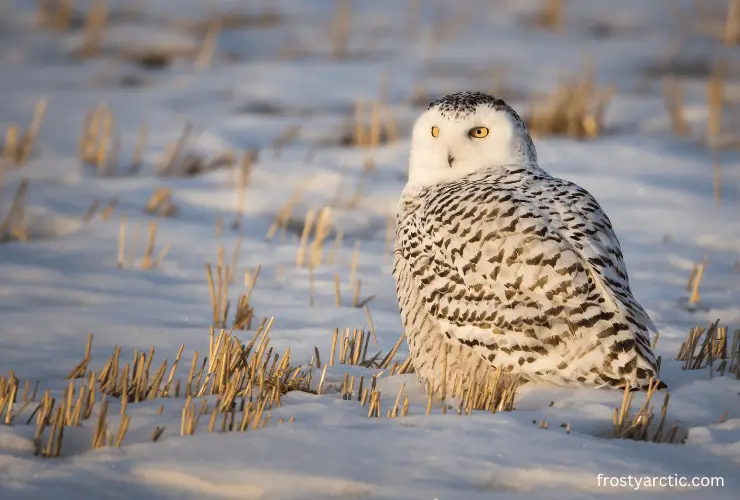
Snowy owls can see farther than other owls. Barn owls can see things from 6 to 7 feet away. Similarly, the giant eyes of snowy owls are developed in such a way that they can easily see long distances. But do they struggle to see the closest things? Yes!
Some studies say that snowy owls can detect small mammals, lemmings, or birds from distances of several hundred meters in darkness. However, the exact distance is still under study. Still, one of the studies states that snowy owls can watch objects at a distance of 1.6 km.
This means they can watch prey from approximately 1 mile away. The distance of watching at night and day also depends on the size and color of the object, weather conditions, and light availability.
Do Snowy Owls Have Eyelids?
Yes, snowy owls do have eyelids. They have three eyelids, just like other birds of prey: ~ Source
- Upper Eyelid
- Lower Eyelid
- Nictitating membrane
Their names clearly define their functions. The upper eyelid closes in a downward position when the snowy owl blinks. They look so cute when they blink their eyes or close them completely. This is my personal experience. Anyhow, when the owl is half asleep or fully asleep, the lower eyelid closes in an upward position.
The third eyelid is very special. Let’s see how? This is commonly known as a “nictitating membrane”. The third eyelid can move horizontally from the inner corner to the outer corner of the owls’ eyes.
In this way, it helps moisturize the big, bulging eyes and protects them from getting dry. This eyelid is translucent. That’s why snowy owls can still see objects even when the third eyelid is closed. Parent snowy owls can also protect their eyes when they are feeding owlets.
Why Do Snowy Owls Have Large and Yellow Eyes?
According to the research, the eye color of owls tells a lot about their hunting behavior. For example, owls that have black or brown eyes are counted as nocturnal. The orange-colored eyes of owls are crepuscular. Similarly, yellow-eyed owls are diurnal. However, much evidence shows how owls evolve during their hunting time period despite their eye color-related behavior.
There could be many reasons behind this change in behavior. According to a published paper, true owls have bright irises and are nocturnal. Snowy owls have yellow and bright irises, which show their nocturnal behavior. The study also states:
“Yellow and bright irises help the snowy owls hide in the dark. They can completely blend in with the surroundings to get disguised.” ~ Source
Thus, their natural environment and hunting habits are closely related to why they have big yellow eyes. Moreover, snowy owls experience long periods of darkness during the winter months. Their large and beautiful eyes can gather more and more light in the darkness. That’s why they see their prey in dim or low-light conditions.
The yellow coloration of snowy owls’ eyes is thought to serve a purpose similar to that of other birds. The bright yellow eyes of snowy owls can intimidate potential threats or prey. They act as a visual deterrent. This major factor gives predators an advantage by making them appear more alert.
Camouflage is another reason. The yellow eyes can act as a visual contrast against the white plumage. This color contrast helps other owls identify them from a distance. Still, much more research is needed to find out why they have big and bright yellow eyes.
Snowy Owls’ Eyes Vs Human Eyes
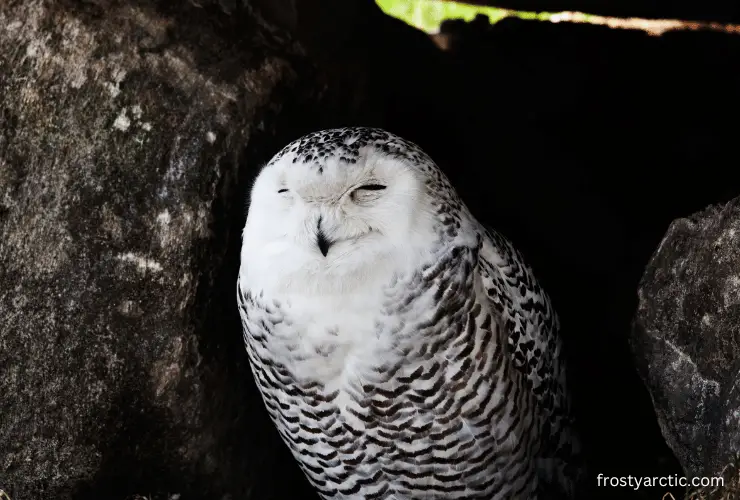
The lens of the human eye and the snowy owl’s eye are the same. The human eye has a curved and convex lens. It is capable of changing its shape based on different circumstances. However, the eye of a snowy owl has a larger retina than the human eye. It results in a larger projected image.
Moreover, the lens of a snowy owl can potentially develop progressive opacity over time. Human eyes are well known to be sensitive to high or excessive light. Similarly, the snowy owls’ eyes can also get damaged by overexposure to light. Both human and owl eyes can become blinded by excessive light.
There is a distinction in the amount of light between the two. The eyes of snowy owls can be impaired, unlike human eyes, with less light reaching their big eyes. But the good news is that they can also get treated. There are custom contact lenses that can help them see better.
According to the modern procedure given by a popular entrepreneur and Bavarian chemist, Christine Kreiner, “these customized contact lenses are applicable for those animals that are totally blind due to more light”.
On the other hand, human eyes have used spectacles and lenses for centuries to see clearly. We found another similarity between snowy owls’ eyes vs. human eyes. Snowy Owls have a total of two lenses, one on each side.
Unique Parts of Snowy Owls’ Eyes
Pecten is another relevant part of the eye of a snowy owl. Human eyes do not have Pecten. So, this is one of the unique parts of snowy owls’ eyes. Pecten includes a group of blood vessels and a comb-like structure. It is present in the outer chamber of the snowy owl’s eye. ~ Source
Fun Fact Time: Snowy Owls’ have a fabulous vision as compared to humans. Their vision is 15 times sharper and better as compared to the vision of humans.
Why Do Snowy Owls See Black and White Only?
We know that snowy owls are nocturnal birds of prey. We also know they have excellent night vision. One of the amazing adaptations that allow them to see well in low light is the presence of rod cells. Actually, a large number of rod cells in their eyes!
Rod cells are more sensitive to light than cone cells. These cells also allow for better vision in dim light. However, this adaptation comes at a high cost of color blindness. We mean to say rod cells cannot detect colors. That’s why snowy owls see any object in black, white, and gray. ~ Source
However, many researchers are also saying that snowy owls can perceive colors, but they do not have the ability to perceive ultraviolet visual pigments. Thus, we can say that snowy owls are limited in their ability to see colors. ~ Source
According to NCBI research, snowy owls lack UV/V cones just like other owls. However, they can easily detect ultraviolet light. The increased opacity of the lens in snowy owls enhances the sensitivity of their rod vision. As a result, they are able to perceive UV-reflecting feathers as brighter signals, particularly during the daytime. ~ Source
FAQs
What time of night do snowy owls come out?
Generally speaking, snowy owls come out for hunting near dusk. Dusk and dawn are their favorite times to come out. Thus, crepuscular periods are their preferred times.
However, they can also update their schedules if they are migrating or living outside the Arctic. Thus, there is no best time for snowy owls to come out of their nests or territories. Still, most of the time, they attend evening walks!
Do snowy owls have eyelashes?
Yes. According to a BBC Earth News report, snowy owls have adapted “eyelashes“. Mostly, owls do not have eyelashes. However, some members of the genus Bubo have eyelashes. These forms of eyelashes are just like the eyelashes of mammal species.
These eyelashes protect the eyes from dirt and debris entering their eyes. Sensory perception also gets easier with the help of these eyelashes. The adapted eyelashes of snowy owls are specifically made up of long bristles and some sort of feather. They also help them to reduce glare. ~ Source
Can snowy owls see in complete darkness?
No, snowy owls cannot see in total darkness. No one can! Every eye requires light to see anything. Some light is always necessary if a human, bird, or animal wants to see something.
However, according to one of our Quora colleagues’ research, snowy owls cannot see in complete darkness, but still they can see well in some dark conditions. However, humans and other animals can’t see in low-light conditions.
Can snowy owls see in the daytime?
Yes, snowy owls can see in the daylight. There is a misconception that snowy owls can see at night but not in the daytime. This is totally wrong. They can see in the darkness and in the lightning too. According to the factual report given by Journey North organization, bright light cannot turn the pupils of snowy owls smaller as compared to human pupils.
By half-opening their eyes, they are experts at balancing the size of their pupils. Whenever we look at them in daylight, they may look sleepy or tired due to half-closed eyes. But the reality is the opposite of this. They are awake and alert, but just trying to fix the pupils of their eyes to get less light. ~ Source
Conclusion
So, can snowy owls see at night? Absolutely yes, no matter if they have darkness all around. They know which way to go. Snowy Owls like moonlighting, and that’s why they are nocturnal masters. In fact, they can perceive darkness and light like no one else. This bird has earned an unmatchable reputation due to its supreme qualities and mysterious nature. If someone saw these owls, they would probably utter, “What big eyes they have”!
We have also tried our best to unravel the secrets associated with the night vision of snowy owls. I hope you like our efforts!
Don’t forget…
To comment about your views on our “eye-opening” article about snowy owls’ night vision. Your suggestions matter a lot! If you have any questions, you can also ask. We would be happy to clear up any ambiguity. Sincere thanks for reading!

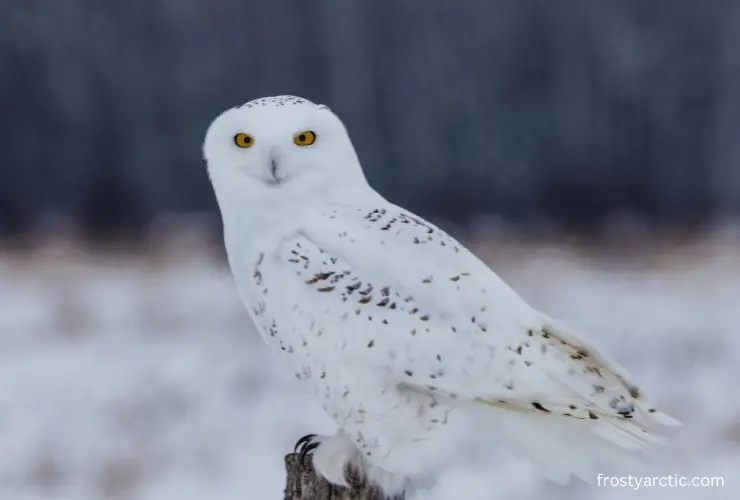

2 thoughts on “Can Snowy Owls See at Night? [Explained]”